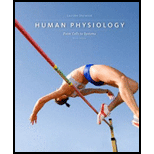
Concept explainers
The rate at which the
Want to see the full answer?
Check out a sample textbook solution
Chapter 4 Solutions
Human Physiology: From Cells to Systems (MindTap Course List)
- Conformational changes in channel proteins brought about by voltage changes are responsible for opening and closing Na+ and K+ gates during the generation of an action potential. (True or false?)arrow_forwardIn excitable cells, such as neurons, K+ is held at a much higher concentration inside the cell than outside. Which of the following would hold K+ at this concentration?arrow_forwardThe membrane potential for an excitable cell membrane is -70 mV, for sodium ions the Nernst equilibrium potential is +50 mV, the conductivity of the single sodium channel is 10 pS. What is the electrochemical potential difference that is the driving force for sodium ions to migrate? How much current flows through an open sodium channel under these conditions?arrow_forward
- Calculate the free energy of transport for the movement of potassium by the sodium/potassium pump under normal physiological conditions: 4 mM serum potassium, 135 mM intracellular potassium, 37.1 °C, and resting potential -82 mV. Express your answer in kJ/mol. Show all work. Calculate the free energy of transport for the movement of potassium by the sodium/potassium pump under disturbed conditions of 2 mM serum potassium. Assume all other parameters remain the same. Express your answer in kJ/mol. Show all work. What factors could limit the continued action of the sodium/potassium pump when only 2 mM potassium is present in the blood plasma? Note that under normal physiological conditions, the cell interior contains 11 mM sodium and the blood contains 140 mM sodium.arrow_forwardHyperkalemia is a condition by which ECF potassium levels become too high (usually due to kidney failure). Consider the following questions about the consequence of hyperkalemia on membrane potential. How would hyperkalemia affect EK? Considering your answer to the previous question, how would hyperkalemia affect membrane potential?arrow_forwardThe compound tetraethylammonium (TEA) blocks the voltage-gated changes in potassium permeability that occurs during an action potential. After administration of TEA, what changes would you expect in the action potential?arrow_forward
- If a particular neuron has an intracellular Chloride concentration of 154.3 mM, an extracellular Chloride concentration of 163.2 mM, and a membrane potential of -54.1, what is the net driving force (in mV) acting upon Chloride?arrow_forwardIf the postsynaptic cell's plasma membrane were to become substantially more permeable to Na+, you would expect the membrane potential to [depolarize, hyperpolarize] __________________. You would expect the membrane potential to depolarize if the extracellular K+ concentration were to [increase, decrease] ______________. a.) hyperpolarize, decrease b.) depolarize, decrease c.) depolarize, decrease d.) hyperpolarize, increasearrow_forwardThe resting membrane potential…A) Can be approximated using the Goldman-Hodgkin-Katz equation.B) Represents a difference in charges across the cell membrane, resulting mostly from the passive flow of Na+ions.C) Has no influence on the driving force that acts on different ions across the cell membrane.D) Is equally dependent on the concentration gradients of potassium and sodium across the cell membrane.E) Becomes hyperpolarized during an excitatory graded potential.arrow_forward
- Describe the contribution of each of the following to the establishment and maintenance of membrane potential: Part A Na+K+ Pump Passive movement of K+ across the membrane Passive movement of Na+ across the membrane Part B Resting membrane potential is approximately -70mV. Explain what resting membrane potential is and what -70mV refers to.arrow_forwardDraw details of the repolarization phase of an action potential from the following descriptions of the sequences of AfterHyperPolarization (AHP) and AfterDePolarization (ADP) sequences. Make the distinct phases clear and noticeable (5 % each) A complex AHP consisting of a first component AHP, an ADP, and a second component AHP before repolarization to resting membrane potential a first fast AHP component, followed by a slower AHP, followed by a fast ADP, and a second late AHP component before repolarization to restarrow_forwardHyperkalemia was discussed at length in this module. If a cell is experiencing hyperkalemia, what could you do to get the action potential duration looking more like normal? a. Add more extracellular sodium b.Add more intracellular sodium c.Add more intracellular potassium d.Add more extracellular potassiumarrow_forward
 Human Physiology: From Cells to Systems (MindTap ...BiologyISBN:9781285866932Author:Lauralee SherwoodPublisher:Cengage Learning
Human Physiology: From Cells to Systems (MindTap ...BiologyISBN:9781285866932Author:Lauralee SherwoodPublisher:Cengage Learning

